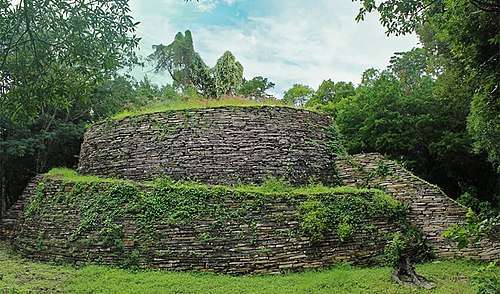El Sabinito
El Sabinito is the ruin of a Pre-Columbian settlement formerly occupied by the Huastecs in the Mexican state of Tamaulipas. It is located approximately 25 kilometers southwest and 96 kilometers southeast of modern cities Soto la Marina and Ciudad Victoria, respectively. Along with the Balcon de Montezuma, El Sabinito embodies the northernmost cultural extent of Mesoamerican civilization.
| Location | Soto la Marina Municipality, Tamaulipas, Mexico |
|---|---|
| Region | Sierra de Tamaulipas |
| Coordinates | 23°37′40″N 98°22′6.4″W |
| History | |
| Founded | 200 CE |
| Abandoned | 1300 CE |
| Periods | Classic to Post-Classic |
| Cultures | Huastec |
| Site notes | |
| Discovered | 1987 |
History and description
El Sabinito was discovered in 1987 by Aureliano Medina in an almost virgin region of tropical jungle with suffocating humidity.[1] Today, the area lies within the municipality of Soto la Marina and north of the Sierra de Tamaulipas.
Relative to other Pre-Columbian ruins in the state of Tamaulipas such as the Balcon de Montezuma and the Pyramid of Tammapul, El Sabinito represents the most urbanized and most culturally significant settlement established by the Huastec civilization in the area.[2] The Huastecs of Tamaulipas originally had their roots in the Mayan culture, but migrated northward to the present-day state around roughly 1300 BCE, and took a thousand years before they adopted some customs of the local, less agrarian tribes. Archaeological remains indicate that human activity around the vicinity of the Soto la Marina River first sprung up as early as 10,000 BCE,[3] while the Huastec construction and occupation of El Sabinito only began in 200 CE. El Sabinito showed signs of decadence around 1000 CE, and the last signs of Huastec occupation in the settlement decisively ceased to exist from 1300 CE onward.[4]
El Sabinito was a large village of more than 600 foundations.[5] Based on the discovery of 500 residential structures out of those foundations, Mexican archaeologists approximate that El Sabinito had a population of 2,500 inhabitants at its peak.[6]
Due to its placement atop the tallest of a group of irregular hills and the presence of a number of formidable terraces and embankments, El Sabinito may have functioned as an observation and control post from which it was possible to monitor incursions by warring nomadic groups. As such, the makeup El Sabinito's constructs suggests that in addition to being a Huastec town of cultural, and residential importance, El Sabinito may have doubled as a major stronghold of military and political power as well.[5]
Architecture
All the buildings of El Sabinito are very well preserved. As mentioned above, excavations of the site performed by INAH resulted in the finding of more than 600 foundations built on terraces, corridors, and plazas arranged symmetrically in a manner that demonstrates a fairly advanced knowledge of architecture.[5]
The area of El Sabinto can be divided into two parts, based on its two major plazas.
Plaza 1
The first plaza is most notably marked by its northernmost and the sizable edifices which flank it, the largest within El Sabinito.[7] Outstanding among these constructions is the circular, eight-meter-high pyramid, with slabs of limestone jutting out of its sides like the arms of a windmill. This particularly conical style of pyramid has been noted to generally correlate with worshiping the god Ehecatl.[8] Opposite this pyramid is a ceremonial altar measuring 2 meters wide by 6 meters long with unevenness at the ends

Plaza 2
Two large circular twin buildings that start from the hillside stand out, linked together by a wall with a staircase to reach a ceremonial plaza, which is also accessed by means of terraces staggered by other buildings that surround it.
See also
- La Huasteca
- Mesoamerican architecture
- Archaeology in Mexico
References
- "Zona arqueológica El Sabinito, Tamaulipas". México Desconocido (in Spanish). 2010-08-31. Retrieved 2020-04-16.
- "Municipio de Soto la Marina, Tam". www.sotolamarina.gob.mx. Retrieved 2020-04-16.
- "Zona Arqueológica El Sabinito". www.inah.gob.mx. Retrieved 2020-04-16.
- Mena Cruz, Alberto. "El Sabinito". Mexicana.
- A. Ramirez Castilla, Gustavo (September 2004). "From Semi-Desert to Jungle The Ancient Peoples of Tamaholipa" (PDF). Voices of Mexico. 68: 98 – via National Autonomous University of Mexico.
- "El Sabinito". Secretaría de Cultura/Sistema de Información Cultural (in Spanish). Retrieved 2020-04-16.
- https://mexicana.cultura.gob.mx/en/repositorio/detalle?id=_suri:MEDIATECAGUIA:TransObject:5bc501667a8a0222efe6898b&word=El%20Sabinito,&r=0&t=65
- "Ehecatl". Ancient History Encyclopedia. Retrieved 2020-04-16.